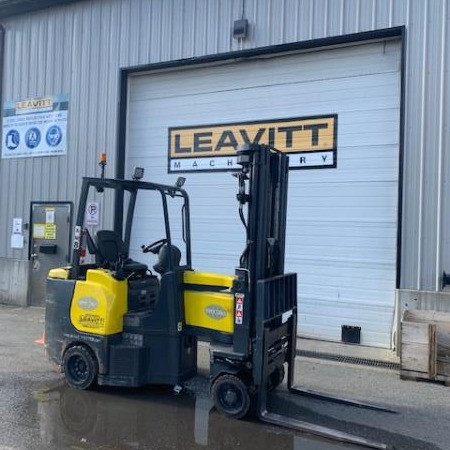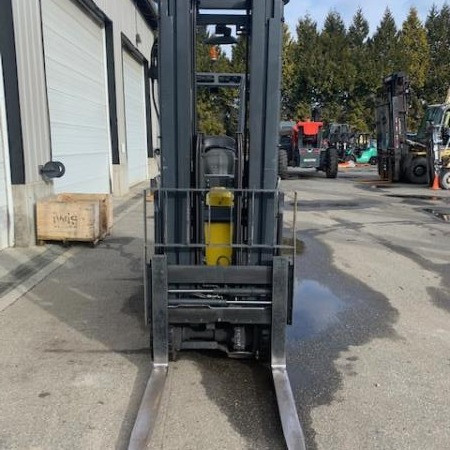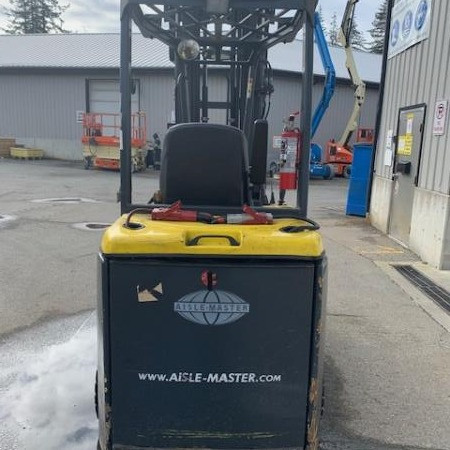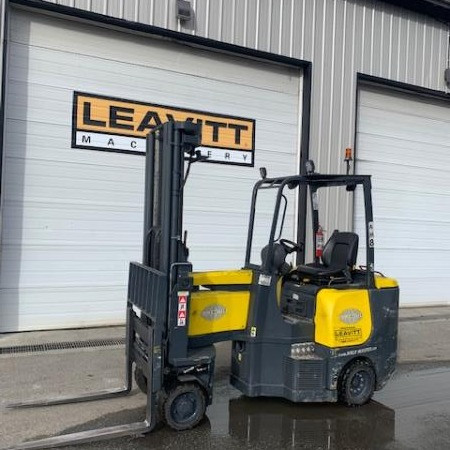Very Narrow Aisle Forklift Vermont
Used Very Narrow Aisle Forklift Vermont - Getting items from one warehouse location to another and to and from the loading docks is the focus of warehousing. Focus is often on space saving tools and the layout of the building. Very narrow aisle solutions allow for more space to be dedicated to the storage of goods because less space is required for aisle access. These warehouse configurations are often referred to as warehouse optimization.
Warehouse Optimization
Implementing very narrow aisle warehouse optimization is a huge benefit of warehouse optimization. One of the most important benefits is the increased storage space.
Because very narrow forklift trucks were developed to take up less space in maneuvering, it is now possible to decrease warehouse aisle width to less than half the width required by standard forklifts. Numerous narrow aisle forklifts deliver better stacking heights to increase the storage capacity on a square foot basis. Very narrow aisle forklifts can greatly reduce costs compared to traditional forklifts since the same amount of stock takes up less space in the warehouse. Square footage is costly in urban areas and any way to reduce warehousing costs can save a company money. Adding a very narrow aisle width system can increase storage up to eighty percent when planned properly. Very narrow aisle design facilitates greater product access and more rack faces. Reduced travel time for storing items and gathering products are some of the key benefits to this warehouse layout as more products are found in an accessible location.
Warehouse layouts usually utilize a narrow aisle or very narrow aisle plan. Less than eleven feet of aisle width is needed by narrow aisles. Very narrow aisles usually use an aisle width of approximately 6.5 feet across. Both of these aisle widths provide significantly increased storage opportunities. However, they also create challenges when turning within the aisles using forklifts for stocking and order picking. These challenges are met by using very narrow forklifts to gain access and complete tasks.
Before choosing a forklift for a particular job, it is vital to know the dimensions of the aisle. It is important to have the correct aisle dimensions before forklift shopping to avoid securing a machine that won’t fit its’ intended location. It is essential to take any columns, posts or utilities into account before deciding a type of narrow aisle forklift design as these can block access.
Very Narrow Aisle Forklift Trucks
Rechargeable batteries are typical for powering very narrow aisle forklift trucks and most models are electric. These very narrow aisle trucks are more commonly available as stand-up riders, which helps increase productivity and operator comfort. There are different very narrow aisle forklift designs such as order pickers, reach trucks, wing-mast or turret and end-control riders.
Reach Forklift Trucks
Reach trucks were designed as a version of the rider stacker forklift but specially modified for use in narrow aisles. The reach trucks developed their name from their forward-reaching actions to get a load. There are two types of reach trucks: the moving mast and the moving carriage. The moving carriage works by raising and lowering the carriage, along with the operator. The moving mast works by raising and lowering the forks along the mast, while the operator stays at ground level. The moving mast reach truck is generally considered the safer of the two types of reach trucks. Reach trucks utilize a pantograph system that is a jointed framework design enabling the driver to place and reach loads without moving the forklift.
Order Pickers
Order pickers have been created to pick items from difficult, high racking systems. They are used for smaller picking items that can be lifted and moved by hand. They lift the operator up to reach the goods by identifying and choosing certain items to create an order.
End-Control Riders
End-control riders are used to pick loads located at floor level and transport the load horizontally, rather than lift or lower loads from various heights.
Turret or Swing-Mast Forklift
Swing-mast or turret very narrow aisle forklifts feature an articulating swivel mast that pivots. The mast swivels to enable pallets to be positioned on the right or left side of the forklift.
Guided Very Narrow Aisle Trucks
Many very narrow aisle forklift trucks are able to be guided down aisles by wire or rail.
Because the forklift is guided, thereby reducing the possibility of the forklift bumping racks while moving down the aisle, the aisles can be extremely narrow. In rail-guided models, sets of rails are placed into the floor on each side of the aisle. They run the length of the aisle and also curve around the aisles’ edge. Wheel guides on the forklift slide into the floor rails to stop the machine from traveling out of bounds.
Running down the center of the aisle, wire-guidance forklifts rely on floor wires instead of rails. These wire-guides work along the same principle as the rail guards except that the narrow aisle forklift is fitted with a wire-guide system that allows it to communicate with the floor wires which effectively steer the forklift, preventing it from straying outside of an allotted range.
Work Site Considerations
To use a narrow aisle configuration, there are some key considerations that need to be made. Because these very narrow aisle configurations include very tall racking systems, the condition of the floor and the construction of the racks must be done properly in order to avoid potentially disastrous outcomes. There are four main locations that need to be ideally prepared before any racking system can be installed. These areas need to be monitored continuously including fixing cracks in the floor, ensuring the racks are straight, a level floor and an appropriate load capacity of the floor.
Level Floor
Because of the height of the racking systems, any slight slope of the floor is likely to negatively affect the plumbness of the racks, especially over time when loads are continuously placed and removed on the racks. Without this foundation of a level floor, the stability of the racks could be jeopardized.
Crack Repair
Cracks in the floor ideally should be fixed once they are noticed to ensure everyone’s safety. The level of the floor can become unstable with cracks when they are only 3/8 inches wide. They will need to be filled properly with material as hard as the rest of the floor.
Floor Load Capacity
The floor should meet certain minimum requirements before considering a narrow aisle configuration. At a minimum, the floor should consist of 3,000 psi concrete as well as contain evenly distributed rebar approximately 3 to 4 inches below the surface. Extra reinforcements might be needed depending on the load requirements and the configuration.
Plumb Racks
Of great importance is the proper installation of the racking system. If installed improperly, there is a great chance of rack failure. One of the most important details to ensure proper installation, is that all racks are plumb. If necessary, rack shims should be used to ensure the racks are plumb within 1 inch at the 30 foot height of the racks.
If the above measures are not taken or are improperly implemented, it is likely to cause a racking failure. Such failure is likely to result in costly damage to goods, the warehouse facility, forklifts and, worst of all, employees could be significantly injured or even killed. Due to these potential problems, the most significant part of creating a narrow aisle configuration for warehousing optimization is the initial measurements.
Very Narrow Aisle Forklift PDF
Stock Number: 209213 GL
Make: AISLEMASTER
Model: 44SE
Year: 2015
| Stock Number |
209213 GL |
| Make |
AISLEMASTER |
| Model |
44SE |
| Year |
2015 |
| Category |
Very Narrow Aisle Forklift |
Stock Number: 208758 GL
Make: AISLEMASTER
Model: 44SE
Year: 2015
| Stock Number |
208758 GL |
| Make |
AISLEMASTER |
| Model |
44SE |
| Year |
2015 |
| Category |
Very Narrow Aisle Forklift |
Stock Number: 207213 GL
Make: AISLEMASTER
Model: 44E
Year: 2013
| Stock Number |
207213 GL |
| Make |
AISLEMASTER |
| Model |
44E |
| Year |
2013 |
| Category |
Very Narrow Aisle Forklift |













